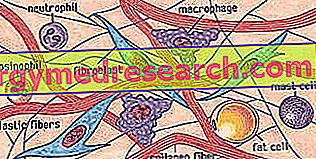What's this
A dry skin is a sensitive skin, easily prone to cracking, cracking and irritation. In fact, in a too dry skin sweat and natural fats are not enough to protect it from pressure, rubbing, atmospheric agents and insults in general.

General advice
The general tips to follow in case of suffering of dry and cracked skin concern above all the adequate water supply (to maintain a good level of hydration also from the inside) and the protection (fundamental) from the harmful action of the sun rays and from the others atmospheric agents (such as wind and cold).
Similarly, skin cleansing products that are delicate and of high quality are of fundamental importance.
Furthermore, the environment in which you stay should not be too cold or too hot; in particular the right humidification will be sought.
Those just listed are simple but not to be underestimated, because they shelter the entire body, and not just the skin, from the ravages of time and the environment.
A dry skin, however, will need to be rehydrated, not only from the inside, but also from the outside. For this purpose, water is not enough, because it tends to slip away without being able to penetrate deeply. For this reason there are specific cosmetics for dry and dehydrated skin, which reproduce the hygroscopic properties (capable of retaining water) of the natural factor of skin hydration.
Alongside these components (generally amino acids, hyaluronic acid, urea and sodium lactate), substances capable of slowing the loss of water through the superficial layers of the skin are added, without thereby preventing normal water and gaseous exchanges with the environment.
Let's see, in detail, which are the most appropriate cosmetics to hydrate and nourish a dry skin in depth.
Cosmetic treatment
The main purpose of modern cosmetics applied to the treatment of dry skin is not simply to increase the percentage of water in the most superficial layers: what is really important is to optimize the physiological processes that ensure the maintenance of the same water component.
Normally, the cosmetic treatment to improve a dry skin involves the application of more substances than the different action:
- Humectants and gelling agents.
- Film-forming and occluding cosmetics.
- Emollients.
- Bee products.
- Home treatments.
Humectants and gelling agents

The most suitable wetting and moisturizing substances for the treatment of dry skin are:
- Polyols : sorbitol, glycerol, maltitol.
- Alpha-hydroxy acids (at low concentrations): malic acid, tartaric acid, citric acid, glycolic acid, ubiquitous in fruits such as strawberries, grapes and lemons. Let us briefly recall that these substances can effectively counteract skin dryness only if used at low concentrations. Unlike (high concentrations), alpha-hydroxy acids are used as exfoliants.
- Cosmetic ingredients that reproduce the hygroscopic properties (capable of retaining water) of the natural skin hydration factor ( NMF )
- Hyaluronic acid : hyaluronic acid creams are particularly suitable for deeply moisturizing the skin, countering at the same time the typical signs of aging, such as expression lines and crow's feet.
- Hydrolyzed collagen : by absorbing massive amounts of water, the collagen fibers form a moisturizing gel on the skin surface that can preserve the skin from dehydration. For this reason, collagen creams are an excellent remedy for dry skin.
- Mucilages, richly present in extracts of mallow, aloe vera, altea, linden.
- Pectins, abundant in rose and cornflower.
- Silk proteins (eg sericin): cosmetics formulated with silk proteins interact positively with the surface of the skin through bio-adhesion mechanisms. Thanks to these processes, the sericin has an extremely positive effect since it gives rise to a protective elastic film on the skin, thus ensuring a good skin hydration.
Filmogens and occluders
Forming a sort of occlusive film on the skin, the film-forming and occluding cosmetics reduce the evaporation of water from the superficial epidermal layers; consequently, skin hydration is maintained. The occluding substances used in the treatment of dry skin are generally ingredients of hydrocarbon origin, such as Vaseline and mineral oils . Once distributed on the skin, these substances form a protective film on the skin, such as to hinder the loss of skin water.
Curiosity
Today, Vaseline and mineral oils are poorly used in the treatment against dry skin: these substances, in fact, tend to interfere negatively with some physiological mechanisms of the skin, also presenting a poor dermocompatibility. The use of vaseline-based cosmetics / mineral oils is generally reserved for rather serious dermatological situations for which expert advice is recommended.
Emollients
The emollient substances, highly skin-compatible, are widely used in the treatment of dry skin: these products - by replenishing the lipophilic component of the skin - are able to effectively restore the barrier function of the skin, but that is not all. The emollient substances give a soft and smooth appearance to dry skin, since they are able to mimic the role of lipids naturally present in the superficial layers of the epidermis.
The most suitable emollient cosmetic ingredients for the treatment of dry skin include:
- Vegetable oils : avocado oil, hemp oil, wheat germ oil, borage oil, macadamia oil, sweet almond oil, palm oil, olive oil etc.
- Vegetable butters and butter: shea butter, cocoa butter, jojoba oil (liquid wax).
- Squalene : abundant in olive oil, rice bran, peanuts and wheat germ. Due to its poor stability, in cosmetics, squalene is often replaced by squalane, a substance capable of protecting the skin, regenerating the lipid film and hydrating the skin, reducing water evaporation from the deeper epidermal layers.
- Ceramides : give a soft and velvety appearance to very dry and visibly suffering skins.
- Polyunsaturated fatty acids : vegetable products sources of omega-6 - such as wheat germ oil, oil extracted from sunflower seeds and corn - are often used in cosmetics to make products designed to improve the appearance of skins very dry, prone to flaking.
Bee products
Bee products for the treatment of dry skin deserve further study. The protagonists of this chapter are beeswax and honey, two surprisingly effective natural products in the cosmetic treatment of dry skin.
Beeswax
Its film-forming and emollient properties make beeswax a cosmetic ingredient very suitable for treating dry, dry and chapped skin. Being particularly rich in fatty acids, beeswax encourages the repair of lipids present in the superficial layers of the epidermis, restoring the barrier function (clearly altered) of dry skin. Not surprisingly, beeswax is part of the formulation of professional face and body masks.
Honey

Home remedies
There are several DIY remedies that can be done to counteract the problem of dry skin, while improving its appearance. In detail, home-made masks and natural peels, made with simple and commonly used ingredients, seem particularly useful for the purpose.
Some of these home remedies will be briefly described below.
Zucchini and cucumber mask
The rehydrating properties of courgettes and cucumbers can be used to counteract skin dryness: just blend a courgette and a cucumber, mix everything with a couple of tablespoons filled with liquid cream and the DIY mask for dry skin is ready . The mixture is spread on the skin and left to act for about twenty minutes.
Then, you can proceed to rinsing and applying a good moisturizer in order to enhance what is achieved with the mask.
Natural fruit peeling
Even strawberries, grapes and lemons can be helpful in smoothing dry skin, with a tendency to comedogenesis (dry skin with an asphyxiated tendency) or flaking. The pulp and juice of these fruits are in fact rich in alpha-hydroxy acids, such as malic acid, citric acid and tartaric acid: applied to the skin, these substances exfoliate, stimulating skin renewal and facilitating the release of sebum from the follicle.
A periodic natural peeling, performed for example with crushed strawberry and grape pulp, brings significant benefits to dry and dehydrated skin. These treatments must be performed on a well-hydrated skin (for example immediately after a shower) and followed by the application of an oily product to restore the right hydration to dry skin.
Face mask with honey and olive oil
The honey and olive oil face mask is able to exert an excellent moisturizing action against dry and dry skin and is definitely easy to prepare. In fact, it is sufficient to mix two tablespoons of honey with two tablespoons of olive oil. The mixture thus obtained is applied to the face and left on for 10-15 minutes. Then you can proceed to rinse and apply a good moisturizer for the face.
For other recipes, see the article "Examples of DIY Facial Masks".



